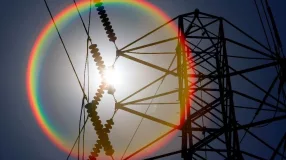On June 26, 2019, INGAA and the INGAA Foundation hosted a Natural Gas Pipeline Technology Showcase on Capitol Hill, educating lawmakers, federal agencies and their staff members on the different types of inspection tools used to inspect interstate natural gas transmission pipelines. Four service providers displayed their in-line inspection (ILI) tools, also known as “smart pigs,” demonstrating their features and sharing examples of the data they collect. We spoke to a representative from each company to learn more about the technologies they deploy to keep our natural gas infrastructure safe.
– – – – –
Company name: Enduro Pipeline Services
HQ location: Tulsa, OK
Q&A with Dwane Laymon, CEO
Q: What is the name of the tool you presented at the event and how does it work?
A: The inspection tool we presented is called a Digital Flux Logger (DFL), an axial directed magnetic flux tool carrying five different data sets:
- Magnetic Flux Leakage (MFL) – Determines the extent and location of metal loss on the pipeline due to corrosion of the steel pipe
- Residual Field (measures the residual field left on the pipeline after the magnetic field passes) – Can see stress in the pipe due to bending processes, and can see cad welding, which is associated with the application of a welded connection to a sacrificial anode, designed to prevent corrosion on the pipeline
- Caliper – The caliper section is recorded and mated to the metal loss field (MFL data) and not only sizes denting on the line but confirms gouge of the pipeline by relating a dent aspect to the aspect of metal loss being seen at the same location in both distance and clock orientation. Caliper can record down to .001 of one inch; typical dent sizing generally goes to 1% of pipe O.D. for reporting needs (top of pipe section) and 2% to bottom of pipe section. Expansion is also recorded, sometimes found as manufacturing of the pipe issues or over-pressure during hydrostatic pressure testing during construction of the line.
- Internal from External defect determination – Discrimination of the surface-area location of corrosion is important to the repair process and assists in the client’s ability to determine they are at the correct excavation point.
- Mapping of locations with GPS coordinates – Each of the Enduro ILI tools carry inertial navigation system (INS) packages. GPS is calculated to each event logged during the running of the ILI tool. To enhance this process, Enduro will place above-group markers (AGMs) at intervals along the pipeline. These AGMs record the ILI passage time and collect the GPS coordinates as taken from satellites, providing exact sub-millimeter locations of the AGM units. This GPS data is used to provide check points for the INS unit to correct, if needed, and produces exact location data along the entire length of the line.
Q: What makes this tool effective? Is it unique in the technology it uses?
A: What makes the tool effective is the combination of technologies (five data sets) all working to provide the best data set in the industry. This is the only tool marketed that incorporates this many data sets into one working unit on each and every project.
Enduro provides an in-field report on the complete project outcome, meaning every sensor and every data set is checked to determine completeness and ensure predictions of metal loss are correct and attainable.
Q: What do you think is most surprising about this technology – or pipeline safety efforts in general – to those outside the natural gas pipeline industry?
A: The surprise I see related to this industry is the lack of knowledge among the public and the government officials. The public generally is not aware of the location of pipelines within their immediate area, nor any idea about the technology passing under their feet that is being used to determine the serviceability of the pipeline. The idea that these pipelines are checked every seven years for corrosion, and that repairs are a daily occurrence within the industry, is unknown to the public at-large.
Q: In addition to the tools and technologies themselves, what other safety and integrity measures does Enduro take to protect the industry’s critical infrastructure?
A: Enduro manufactures pipeline cleaning tools (pigs). While we have a common off-the-shelf variety of cleaning pigs, Enduro excels in the custom pig market. We manufacture custom requirement tools on a very short timeline; from conception to shipping, we produce tools in less than a week, in most cases.
Enduro also manufactures and supplies the industry with gaging plates, the aluminum discs or plates of a special size needed for particular pipeline needs, where the client needs to know the bore restriction within a pipeline segment – generally as a go/no-go tool ahead of an ILI tool run.
Enduro manufactures, rents and/or sells tracking transmitters to be carried by any sort of pipeline pig; these are used to track progress or locate a pig should it become stalled within the pipeline.
Along the line of tracking for progress or location, Enduro also manufactures a portable signaling device that responds to the magnetic field of cleaning pigs or ILI MFL tools. These are used to determine if the pigs have actually launched at the entry point or if the pig has been received at the extraction point. Pipeline pigs are launched and received at above-ground locations and cycled in and out of the length of line being inspected.
Q: Is there anything you’d like to add?
A: In the 43 years that I have been working in the pipeline inspection industry, I am continually amazed with the technology. What was being accomplished 43 years ago, while amazing at the time, was only the very beginning of an industry. What has been accomplished to this current date is still “only the beginning of this industry.” This industry is in constant motion and always in an upward direction, and it is populated with some of the finest people I have ever had the pleasure to work with and be associated with. We love what we do.






